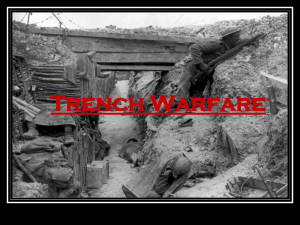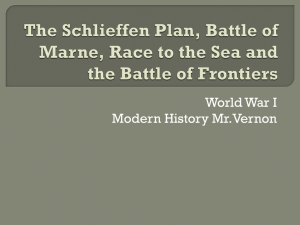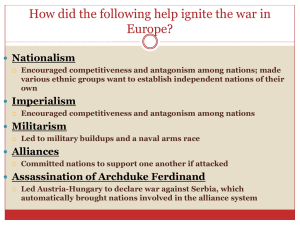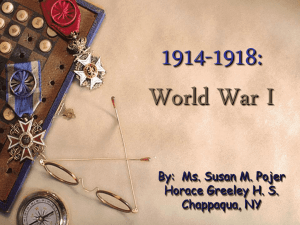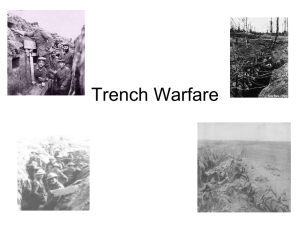D.R.A.W. Technological Advances During the Great
advertisement
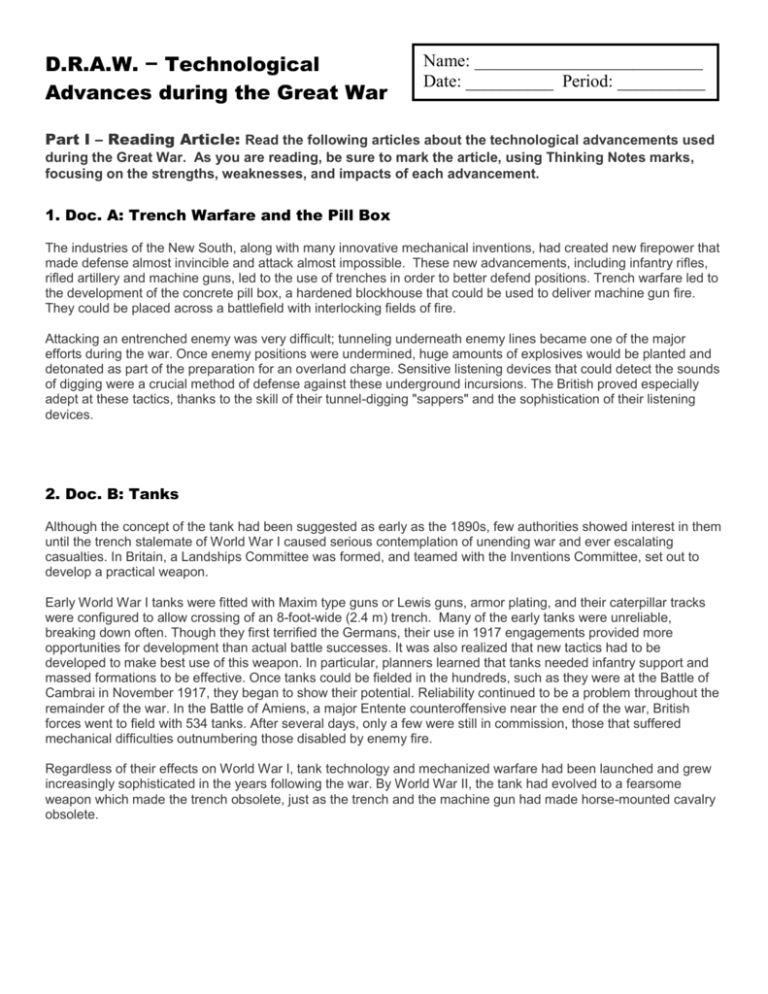
D.R.A.W. – Technological Advances during the Great War Name: __________________________ Date: __________ Period: __________ Part I – Reading Article: Read the following articles about the technological advancements used during the Great War. As you are reading, be sure to mark the article, using Thinking Notes marks, focusing on the strengths, weaknesses, and impacts of each advancement. 1. Doc. A: Trench Warfare and the Pill Box The industries of the New South, along with many innovative mechanical inventions, had created new firepower that made defense almost invincible and attack almost impossible. These new advancements, including infantry rifles, rifled artillery and machine guns, led to the use of trenches in order to better defend positions. Trench warfare led to the development of the concrete pill box, a hardened blockhouse that could be used to deliver machine gun fire. They could be placed across a battlefield with interlocking fields of fire. Attacking an entrenched enemy was very difficult; tunneling underneath enemy lines became one of the major efforts during the war. Once enemy positions were undermined, huge amounts of explosives would be planted and detonated as part of the preparation for an overland charge. Sensitive listening devices that could detect the sounds of digging were a crucial method of defense against these underground incursions. The British proved especially adept at these tactics, thanks to the skill of their tunnel-digging "sappers" and the sophistication of their listening devices. 2. Doc. B: Tanks Although the concept of the tank had been suggested as early as the 1890s, few authorities showed interest in them until the trench stalemate of World War I caused serious contemplation of unending war and ever escalating casualties. In Britain, a Landships Committee was formed, and teamed with the Inventions Committee, set out to develop a practical weapon. Early World War I tanks were fitted with Maxim type guns or Lewis guns, armor plating, and their caterpillar tracks were configured to allow crossing of an 8-foot-wide (2.4 m) trench. Many of the early tanks were unreliable, breaking down often. Though they first terrified the Germans, their use in 1917 engagements provided more opportunities for development than actual battle successes. It was also realized that new tactics had to be developed to make best use of this weapon. In particular, planners learned that tanks needed infantry support and massed formations to be effective. Once tanks could be fielded in the hundreds, such as they were at the Battle of Cambrai in November 1917, they began to show their potential. Reliability continued to be a problem throughout the remainder of the war. In the Battle of Amiens, a major Entente counteroffensive near the end of the war, British forces went to field with 534 tanks. After several days, only a few were still in commission, those that suffered mechanical difficulties outnumbering those disabled by enemy fire. Regardless of their effects on World War I, tank technology and mechanized warfare had been launched and grew increasingly sophisticated in the years following the war. By World War II, the tank had evolved to a fearsome weapon which made the trench obsolete, just as the trench and the machine gun had made horse-mounted cavalry obsolete. 3. Doc. C: Poison Gas At the beginning of the war, Germany had the most advanced chemical industry in the world, accounting for more than 80% of the world's dye and chemical production. Although the use of poison gas had been banned in the Hague Conventions of 1899 and 1907, Germany turned to this industry for what it hoped would be a decisive weapon to break the deadlock of trench warfare. Chlorine gas was first used on the battlefield in April 1915 at the Second Battle of Ypres in Belgium. The unknown gas appeared to be a simple smoke screen, used to hide attacking soldiers, and Allied troops were ordered to the front trenches to repel the expected attack. The gas had a devastating effect, killing many defenders. Later, mustard gas, phosgene and other gases were used. Britain and France soon followed suit with their own gas weapons. The first defenses against gas were makeshift, mainly rags soaked in water or urine. Later, relatively effective gas masks were developed, and these greatly reduced the effectiveness of gas as a weapon. The use of poison gas resulted in brief tactical advantages and caused over 1,000,000 casualties. 4. Doc. D: Air Warfare As with most other technologies, the aircraft underwent many improvements during World War I. Early war aircraft were not much different in design from the original Wright Flyer, which made its first flight over a decade earlier. While early air spotters were unarmed, they soon began firing at each other with handheld weapons and even throwing spears. An arms race commenced, quickly leading to increasingly agile planes equipped with guns. A key innovation was the interrupter gear, a German invention that allowed a machine gun to be mounted behind the propeller so the pilot could fire directly ahead, along the plane's flight path. As the stalemate developed on the ground, with both sides unable to advance even a few miles without a major battle and thousands of casualties, planes became greatly valued for their role gathering intelligence on enemy positions and bombing the enemy's supplies behind the trench lines. Large planes with a pilot and an observer were used to reconnoiter enemy positions and bomb their supply bases. Because they were large and slow, these planes made easy targets for enemy fighter planes. As a result, both sides used fighter aircraft to both attack the enemy's observer planes and protect their own. Germany led the world in the design of Zeppelins, and used these airships to make occasional bombing raids on military targets, London and other British cities, without any great effect. Later in the war, Germany began attacking English cities with long range strategic bombers. Manned observation balloons floating high above the trenches were used as stationary reconnaissance points on the front lines, reporting enemy troop positions and directing artillery fire. By inhibiting the enemy's ability to move in secrecy, aerial reconnaissance over the front can be blamed to some degree for the stalemate of trench warfare. 5. Doc. E: Naval Warfare – Battleships The years leading up to the war saw the use of improved metallurgical and mechanical techniques to produce larger ships with larger guns and, in reaction, more armor. The launching of HMS Dreadnought (1906) revolutionized battleship construction, leaving many ships obsolete before they were completed. Consequently, at the start of the war, many navies comprised newer ships and obsolete older ones. The advantage was in long-range gunnery, and naval battles took place at far greater distances than before. The Battle of Jutland (1916) was the only full-scale battle between fleets in the war. Having the largest surface fleet, the United Kingdom sought to press its advantage. British ships blockaded German ports, hunted down German and Austro-Hungarian ships wherever they might be on the high seas, and supported actions against German colonies. The German surface fleet was largely kept in the North Sea. This situation pushed Germany, in particular, to direct its resources to a new form of naval power: submarines. 6. Doc. F: Naval Warfare – Submarines World War I was the first conflict in which submarines were a serious weapon of war. In the years shortly before the war, the relatively sophisticated propulsion system of diesel power while surfaced and battery power while submerged was introduced. The United Kingdom relied heavily on imports to feed its population and supply its war industry, and the German navy hoped to blockade and starve Britain using U-boats to attack merchant ships in unrestricted submarine warfare. This struggle between German submarines and British counter measures became known as the First Battle of the Atlantic. As German submarines became more numerous and effective, the British sought ways to protect their merchant ships. "Q-ships," attack vessels disguised as civilian ships, were one early strategy. Consolidating merchant ships into convoys protected by one or more armed navy vessels was adopted later in the war. There was initially a great deal of debate about this approach, out of fear that it would just provide German Uboats with a wealth of convenient targets. Thanks to the development of active and passive sonar devices, coupled with increasingly deadly anti-submarine weapons, the convoy system reduced British losses to U-boats to a small fraction of their former level. 7. Doc. G: Small Arms – The Machine Gun The machine gun directly affected the organization of the infantry in 1914, and, by the middle of 1917, put an end to the tactic of company sized waves. Platoons and squads of men became important; hand in hand with that organization was the use of light automatic weapons. The Lewis Gun was the first true light machine gun that could in theory be operated by one man, though in practice the bulky ammo pans required an entire section of men to keep the gun operating (Postwar research would show that its ingenious, but heavy and intricate, air cooling ducts were entirely unnecessary). The Browning Automatic Rifle was adopted by the U.S. Army in 1918; adapters on cartridge belts allowed the BAR man to walk and fire the gun at the same time. Early sub-machine guns were also developed in this period. While in use, these guns would often overheat - which led to the development of several cooling methods. 8. Doc. H: Small Arms – Flame Throwers The Imperial German Army deployed flame throwers (Flammenwerfer) on the West Front attempting to flush out French or British soldiers from their trenches. Introduced in 1915, it was used with greatest effect during the Hooge battle of the Western Front on 30 July 1915. The German Army had two main types of flame throwers during the Great War: a small single person version called the Kleinflammenwerfer and a larger multiple person configuration called the Grossflammenwerfer. In the latter, one soldier carried the fuel tank while another aimed the nozzle. Both the large and small versions of the flame-thrower were of limited use because their short range left the operator(s) exposed to small arms fire. Part II – Evaluative Written Response: Complete an Evaluative Written Response about the technological advancements in weaponry during the Great War (WWI). Explain your answer to the following prompt using text evidence and supporting arguments, including a minimum of three (3) different technological advancements that you feel had the greatest impact. Prompt: How did the technological advancements in military weaponry change the way that wars were fought, starting with the Great War (WWI)? ___________________________________________________________________ ___________________________________________________________________ ___________________________________________________________________ ___________________________________________________________________ ___________________________________________________________________ ___________________________________________________________________ ___________________________________________________________________ ___________________________________________________________________ ___________________________________________________________________ ___________________________________________________________________ ___________________________________________________________________ ___________________________________________________________________ ___________________________________________________________________ ___________________________________________________________________ ___________________________________________________________________ ___________________________________________________________________ ___________________________________________________________________ ___________________________________________________________________ ___________________________________________________________________ ___________________________________________________________________ ___________________________________________________________________ ___________________________________________________________________ ___________________________________________________________________ ___________________________________________________________________ ___________________________________________________________________ ___________________________________________________________________

